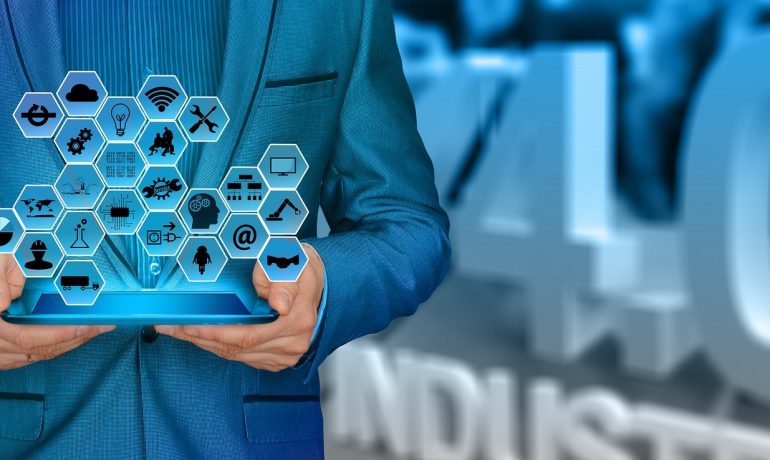Last month we were pleased to have the opportunity to talk at a symposium on Technology Roadmaps to Promote Industry 4.0 in Developing APEC (Asia-Pacific Economic Cooperation) Economies. Our session covered trends underpinning the 4th Industrial Revolution. This is the text of that talk, given by SAMI Director and Fellow, Jonathan Blanchard Smith.
We’ve heard a lot about Industry 4.0 which futurists also call the “Fourth Industrial Revolution”. For us, it means:
- Increasing sophistication of machine learning and adaptive IT systems
- face recognition, AI, robotics, cobots, AI journalists, automated trading, etc.
- and pervasiveness of IT and IoT/smart infrastructure
- 3D printing and decentralised, localised ‘just-in-time’ goods production
- emphasising design/IPR profits rather than production profits
The fourth industrial revolution is what we call a “megatrend”. A megatrend is going to happen, whether we like it or not. It includes things like demographic change, climate breakdown, the shift in global power from the north to the south, from the west to the east. And it includes technological advance – starting with Industry 4.0.
But as we can tell, the fourth industrial revolution, Industry 4.0, is already here. It’s happening, now: face recognition is pervasive not only on your laptop and mobile phone but also in use by the state and the police; websites are using artificial intelligence to write articles; people are printing objects using 3D printing ranging from components to houses. On the space station, a 3D printer produces components and tools using files sent up from NASA ground control.
As William Gibson says, “The future is already here. It’s just unevenly distributed”.
Industry 4.0 is an example of the uneven distribution of the future. You cannot have the internet of things when you do not have reliable electricity or pervasive smart technology (ranging from mobile phones to smart electricity meters). You cannot have wifi if you do not have a telecoms infrastructure. Even if we don’t have those things, though, it’s wise to look at Industry 4.0 now, and we should also note that it is, in some ways, already the present. What futurists are interested in is what happens after the present.
What happens after the fourth industrial revolution? As has been said, “Industry 4.0 is just the first step”.
The next couple of phases are being called Industry 5.0, and Industry 6.0. The distinction is that Industry 5.0 integrates more fully developed AI into industrial processes.
Industry 6.0 gives us “Ubiquitous, customer-driven, virtualized, antifragile manufacturing”. Those four elements are key – it’s everywhere, individualised rather than cookie-cutter, the tech lives on the cloud, and it’s very, very robust.
Inevitably, perhaps, then, we move onto Industry X: where everything that has been developing to date is brought together: the junction point of industry, AI, biotechnology, and the internet of things: green, circular, cognitive manufacturing.
There is already work being done on Industry X, in places like the European Commission, and in companies like Accenture.
This is where the real power lies – when you can bring trends together, and in the interface between them new opportunities arise.
And we must not forget about biotechnology. This is one of the key developments of the future – and we have seen very recent examples of its power in the speed of the development of a wide range of vaccines in the pandemic. But where could it take us?
Let me give you some examples. Futurists talk about “pockets of the future in the present”, and so these things are ones for which there is already evidence: where research is already happening.
• ‘Internet of energy’ – use of microgeneration, decentralised microgrids
• Alternative financial, contracting and governance structures via software innovations like blockchain
• AI used for governance (Big Data, smart cities, evidence-based policy-making)
• Human performance enhancement including mechanical assists, embedded digital technologies, pharmacological assists, and genetic re-design of human capabilities
• Geo-engineering (‘geo-hacking’) to address extreme climate breakdown impacts
These are not forecasts. Futurists do not make forecasts, or predictions. We look at what is happening, and see where it might take us. But they are some examples of where we might be going.
All companies – for example Uber, Zoom, Twitter, BioNtech – start out as SMEs, and in these cases, all were two-person teams. Although they started small, they are now changing the world. What might Industry 4.0 mean for those that are SMEs now? How might they be the motor of, and gain the most benefit from, Industry 4.0 and its future?
• SMEs are the disruptors of change
• They have the ability and flexibility to redesign processes and platforms
• They can upend the perceived way of doing things.
• SMEs can move technology into the real world.
In summary, Small and Medium sized Enterprises can take the benefits of the present, and anticipate the changes in the future, flexibly and fast. They are the engines of the future – of Industry 4.0 right through to Industry X.
Written by Jonathan Blanchard Smith, SAMI Fellow and Director
The views expressed are those of the author(s) and not necessarily of SAMI Consulting.
Achieve more by understanding what the future may bring. We bring skills developed over thirty years of international and national projects to create actionable, transformative strategy. Futures, foresight and scenario planning to make robust decisions in uncertain times. Find out more at www.samiconsulting.co.uk.
If you enjoyed this blog from SAMI Consulting, the home of scenario planning, please sign up for our monthly newsletter at newreader@samiconsulting.co.uk and/or browse our website at https://www.samiconsulting.co.uk
Image by Gerd Altmann from Pixabay


